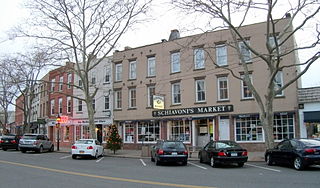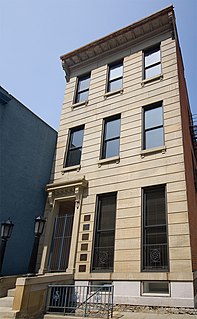
Marcellus is a town in Onondaga County, New York, United States. The population was 6,210 at the 2010 census. The town was probably named after Marcus Claudius Marcellus, a Roman general, by a clerk interested in the Classics.

Federal-style architecture is the name for the classicizing architecture built in the newly founded United States between c. 1780 and 1830, and particularly from 1785 to 1815. This style shares its name with its era, the Federalist Era. The name Federal style is also used in association with furniture design in the United States of the same time period. The style broadly corresponds to the classicism of Biedermeier style in the German-speaking lands, Regency architecture in Britain and to the French Empire style. It may also be termed Adamesque architecture.

Sag Harbor Village District is a national historic district in Sag Harbor, Suffolk County, New York. It comprises the entire business district of the village. It includes 870 contributing buildings, seven contributing sites, two contributing structures, and three contributing objects. It includes the First Presbyterian Church, a National Historic Landmark building designed by Minard Lafever.

The Old Bank of Louisville, also known historically as the Southern National Bank building, is a historic commercial building at 316 West Main Street in downtown Louisville, Kentucky. Completed in 1837, it was designated a National Historic Landmark in 1971 for its exceptionally fine Greek Revival architecture. It currently serves as the lobby for the adjacent Actors Theatre of Louisville.

The Abraham J. Friedlander House is a historic residence in downtown Cincinnati, Ohio, United States. Erected in 1830, it features a facade three stories tall and three bays wide; although brick is employed in some of the walls, both the foundation and the walls are predominantly sandstone. At the time of its construction, the house was used as a multi-person home; its residents were multiple tradesmen in the house's early years. Among its uses since that time has been that of a law office.

First Presbyterian Church in Sag Harbor, New York, also known as Old Whaler's Church, is a historic and architecturally notable Presbyterian church built in 1844 in the Egyptian Revival style. The church is Sag Harbor's "most distinguished landmark." The facade has been described as "the most important (surviving) example of Egyptian revival style in the United States," and "the best example of the Egyptian Revival style in the U.S. today.

St. Ann & the Holy Trinity Church is a historic Episcopal church located at the corner of Montague and Clinton streets in the Brooklyn Heights neighborhood of Brooklyn, New York City.
Minard Lafever (1798–1854) was an American architect of churches and houses in the United States in the early nineteenth century.

The Boston Post Road Historic District is a 286-acre (116 ha) National Historic Landmark District in Rye, New York, and is composed of five distinct and adjacent properties. Within this landmarked area are three architecturally significant, pre-Civil War mansions and their grounds; a 10,000-year-old Paleo-Indian site and viewshed; a private cemetery, and a nature preserve. It is one of only 11 National Historic Landmark Districts in New York State and the only National Historic Landmark District in Westchester County. It touches on the south side of the nation's oldest road, the Boston Post Road, which extends through Rye. A sandstone Westchester Turnpike marker "24", inspired by Benjamin Franklin's original mile marker system, is set into a wall that denotes the perimeter of three of the contributing properties. The district reaches to Milton Harbor of Long Island Sound. Two of the properties included in the National Park designation are anchored by Greek Revival buildings; the third property is dominated by a Gothic Revival structure that was designed by Alexander Jackson Davis.

Rose Hill Mansion is a historic house museum on New York State Route 96A in Fayette, New York. Built in 1837 on a site overlooking Seneca Lake, it is one of the nation's finest examples of monumental residential Greek Revival architecture. The property was declared a National Historic Landmark in 1986. It is now owned and operated by the Geneva Historical Society, and is open for tours in the warmer months.

Government Street Presbyterian Church in Mobile, Alabama is one of the oldest and least-altered Greek Revival church buildings in the United States. The architectural design is by James Gallier, Sr., James H. Dakin, and Charles Dakin. The trio also designed Barton Academy, four blocks down Government Street to the west. Government Street Presbyterian reflects the influences of Ithiel Town, Minard Lafever, and Andrew Jackson Downing. It was declared a National Historic Landmark in 1992.
Chester Hills was author of "The Builder's Guide", an architectural pattern book published in 1846, which, like those of Minard Lafever, influenced architecture in the United States. It is a "practical treatise" on Greek and Roman style architecture.

The Campbell–Whittlesey House, also known as the Benjamin Campbell House, in Rochester, New York is an historic Greek Revival home, designed by architect Minard Lafever. It was built in 1836, and added to the National Register of Historic Places on February 18, 1971.

The Church of the Holy Apostles is an Episcopal parish located at 296 Ninth Avenue at 28th Street in the Chelsea neighborhood of Manhattan, New York City. Its historic church building was built from 1845 to 1848, and was designed by the noted New York architect Minard Lafever. The geometric stained-glass windows were designed by William Jay Bolton. The church faces Chelsea Park across 9th Avenue. The building is a New York City landmark and on the National Register of Historic Places.

The Cobble Hill Historic District is a municipal and national historic district located in the Cobble Hill neighborhood of Brooklyn, New York City. The national district consists of 796 contributing, largely residential buildings built between the 1830s and 1920s. It includes fine examples of Greek Revival, Italianate, and Queen Anne style row houses. Also in the district are a number of notable churches, including ones by Richard Upjohn and Minard Lafever, 1851–52). A number of early 20th century apartment buildings are part of the district as well.

The John B. Kelly House, at 422 South 200 West in Salt Lake City, Utah, was built in 1865. It was listed on the National Register of Historic Places in 1983.

Second Presbyterian Church is a historic Presbyterian church located at 5 N. 5th Street in Richmond, Virginia. It was designed by architect Minard Lafever and was built in 1848. It is a brick veneer Gothic Revival style church with lancet windows and a square pinnacled tower with an arched entrance at the front of the church.

Rose Hill, also known as the Irish-Goetz House, is a historic building located in Iowa City, Iowa, United States. It was built as a farmhouse in 1849 by Frederick Irish, an early settler in this community. His descendants would own this house until 1964. After he arrived in 1839, Irish built a cabin wherein the commissioners chose the site for the new territorial capital and then the design for the building. Irish remained a prominent citizen in Iowa City who was appointed, along with former Governor Robert Lucas, to a group working to bring the railroad to Iowa City. When he built this house he chose the Greek Revival style, which might reflect his relationship with John F. Rague who designed the Capitol building here. It also reflects the housing styles of his native New York, and is very similar to the "farmhouse elevation" found in Minard Lafever's work, Young Builder's General Instructor. The house was listed together on the National Register of Historic Places in 1992.

The Sidney T. Smith House was a farmhouse located at 12880 Michigan Avenue in Grass Lake, Michigan. It was listed on the National Register of Historic Places in 1972. However, the house was destroyed by fire in 1972, and removed in 1978 after its demolition.





















